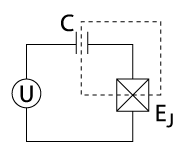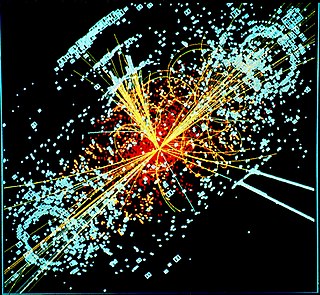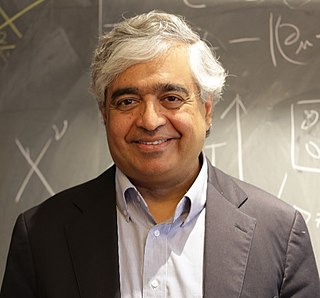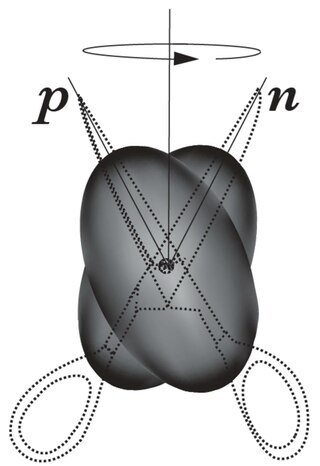Related Research Articles

The triboelectric effect describes when two materials become electrically charged when they contact or slide against each other. This can occur with dissimilar materials, such as the sole of a shoe on a carpet, or between two pieces of the same material. It occurs in various forms and with differing amounts of charge transfer for all solid materials and all contacts and sliding, although sometimes it is so small that it goes unnoticed. There is evidence that it can also occur between a solid and a liquid or a gas.

Samuel Chao Chung Ting is a Chinese-American physicist who, with Burton Richter, received the Nobel Prize in 1976 for discovering the subatomic J/ψ particle. More recently he has been the principal investigator in research conducted with the Alpha Magnetic Spectrometer, a device installed on the International Space Station in 2011.

In quantum computing, a charge qubit is a qubit whose basis states are charge states. In superconducting quantum computing, a charge qubit is formed by a tiny superconducting island coupled by a Josephson junction to a superconducting reservoir. The state of the qubit is determined by the number of Cooper pairs which have tunneled across the junction. In contrast with the charge state of an atomic or molecular ion, the charge states of such an "island" involve a macroscopic number of conduction electrons of the island. The quantum superposition of charge states can be achieved by tuning the gate voltage U that controls the chemical potential of the island. The charge qubit is typically read-out by electrostatically coupling the island to an extremely sensitive electrometer such as the radio-frequency single-electron transistor.

The Belle experiment was a particle physics experiment conducted by the Belle Collaboration, an international collaboration of more than 400 physicists and engineers, at the High Energy Accelerator Research Organisation (KEK) in Tsukuba, Ibaraki Prefecture, Japan. The experiment ran from 1999 to 2010.
Jozef T. Devreese is a Belgian scientist, with a long career in condensed matter physics. He is Professor Emeritus of Theoretical Physics at the University of Antwerp.

In condensed matter physics, a string-net is an extended object whose collective behavior has been proposed as a physical mechanism for topological order by Michael A. Levin and Xiao-Gang Wen. A particular string-net model may involve only closed loops; or networks of oriented, labeled strings obeying branching rules given by some gauge group; or still more general networks.
Quantum dimer models were introduced to model the physics of resonating valence bond (RVB) states in lattice spin systems. The only degrees of freedom retained from the motivating spin systems are the valence bonds, represented as dimers which live on the lattice bonds. In typical dimer models, the dimers do not overlap.

Xiao-Gang Wen is a Chinese-American physicist. He is a Cecil and Ida Green Professor of Physics at the Massachusetts Institute of Technology and Distinguished Visiting Research Chair at the Perimeter Institute for Theoretical Physics. His expertise is in condensed matter theory in strongly correlated electronic systems. In Oct. 2016, he was awarded the Oliver E. Buckley Condensed Matter Prize.
Light dark matter, in astronomy and cosmology, are dark matter weakly interacting massive particles (WIMPS) candidates with masses less than 1 GeV. These particles are heavier than warm dark matter and hot dark matter, but are lighter than the traditional forms of cold dark matter, such as Massive Compact Halo Objects (MACHOs). The Lee-Weinberg bound limits the mass of the favored dark matter candidate, WIMPs, that interact via the weak interaction to GeV. This bound arises as follows. The lower the mass of WIMPs is, the lower the annihilation cross section, which is of the order , where m is the WIMP mass and M the mass of the Z-boson. This means that low mass WIMPs, which would be abundantly produced in the early universe, freeze out much earlier and thus at a higher temperature, than higher mass WIMPs. This leads to a higher relic WIMP density. If the mass is lower than GeV the WIMP relic density would overclose the universe.

Subir Sachdev is Herchel Smith Professor of Physics at Harvard University specializing in condensed matter. He was elected to the U.S. National Academy of Sciences in 2014, and received the Lars Onsager Prize from the American Physical Society and the Dirac Medal from the ICTP in 2018. He was a co-editor of the Annual Review of Condensed Matter Physics from 2017-2019.

In quantum electrodynamics (QED), the Schwinger limit is a scale above which the electromagnetic field is expected to become nonlinear. The limit was first derived in one of QED's earliest theoretical successes by Fritz Sauter in 1931 and discussed further by Werner Heisenberg and his student Hans Heinrich Euler. The limit, however, is commonly named in the literature for Julian Schwinger, who derived the leading nonlinear corrections to the fields and calculated the rate of electron–positron pair production in a strong electric field. The limit is typically reported as a maximum electric field or magnetic field before nonlinearity for the vacuum of

In condensed matter physics, a time crystal is a quantum system of particles whose lowest-energy state is one in which the particles are in repetitive motion. The system cannot lose energy to the environment and come to rest because it is already in its quantum ground state. Because of this, the motion of the particles does not really represent kinetic energy like other motion; it has "motion without energy". Time crystals were first proposed theoretically by Frank Wilczek in 2012 as a time-based analogue to common crystals – whereas the atoms in crystals are arranged periodically in space, the atoms in a time crystal are arranged periodically in both space and time. Several different groups have demonstrated matter with stable periodic evolution in systems that are periodically driven. In terms of practical use, time crystals may one day be used as quantum computer memory.

Scissors Modes are collective excitations in which two particle systems move with respect to each other conserving their shape. For the first time they were predicted to occur in deformed atomic nuclei by N. LoIudice and F. Palumbo, who used a semiclassical Two Rotor Model, whose solution required a realization of the O(4) algebra that was not known in mathematics. In this model protons and neutrons were assumed to form two interacting rotors to be identified with the blades of scissors. Their relative motion (Fig.1) generates a magnetic dipole moment whose coupling with the electromagnetic field provides the signature of the mode.
Hyperuniform materials are characterized by an anomalous suppression of density fluctuations at large scales. More precisely, the vanishing of density fluctuations in the long-wave length limit distinguishes hyperuniform systems from typical gases, liquids, or amorphous solids. Examples of hyperuniformity include all perfect crystals, perfect quasicrystals, and exotic amorphous states of matter.
Bernstein–Greene–Kruskal modes are nonlinear electrostatic waves that propagate in an unmagnetized, collisionless plasma. They are nonlinear solutions to the Vlasov–Poisson equation in plasma physics, and are named after physicists Ira B. Bernstein, John M. Greene, and Martin D. Kruskal, who solved and published the exact solution for the one-dimensional case in 1957.
In condensed matter physics, a Bogoliubov quasiparticle or Bogoliubon is a quasiparticle that occurs in superconductors. Whereas superconductivity is characterized by the condensation of Cooper pairs into the same ground quantum state, Bogoliubov quasiparticles are elementary excitations above the ground state, which are superpositions of the excitations of negatively charged electrons and positively charged electron holes, and are therefore neutral spin-½ fermions. These quasiparticles are named after Nikolay Bogolyubov.
Many-body localization (MBL) is a dynamical phenomenon occurring in isolated many-body quantum systems. It is characterized by the system failing to reach thermal equilibrium, and retaining a memory of its initial condition in local observables for infinite times.
Toshiki Tajima is a Japanese theoretical plasma physicist known for pioneering the laser wakefield acceleration technique with John M. Dawson in 1979. The technique is used to accelerate particles in a plasma and was experimentally realized in 1994, for which Tajima received several awards such as the Nishina Memorial Prize (2006), the Enrico Fermi Prize (2015), the Robert R. Wilson Prize (2019), the Hannes Alfvén Prize (2019) and the Charles Hard Townes Award (2020).
Sergei Vladimirovich Bulanov, is a Russian physicist. He received the 1983 State Prize of the USSR, the 2016 Hannes Alfvén Prize for "contributions to the development of large-scale next-step devices in high-temperature plasma physics research", and the Order of Rising Sun with Gold Rays and Rosette in 2020.

An electron-on-helium qubit is a quantum bit for which the orthonormal basis states |0⟩ and |1⟩ are defined by quantized motional states or alternatively the spin states of an electron trapped above the surface of liquid helium. The electron-on-helium qubit was proposed as the basic element for building quantum computers with electrons on helium by Platzman and Dykman in 1999.
References
- ↑ Vick, F.A. (1953). "Theory of contact electrification". British Journal of Applied Physics. 4 (S2): S1–S5. Bibcode:1953BJAP....4S...1V. doi:10.1088/0508-3443/4/S2/301. ISSN 0508-3443.
- ↑ Harper, W. R. (1998). Contact and frictional electrification. Laplacian Press. ISBN 1-885540-06-X. OCLC 39850726.
- ↑ Lowell, J.; Rose-Innes, A.C. (1980). "Contact electrification". Advances in Physics. 29 (6): 947–1023. Bibcode:1980AdPhy..29..947L. doi:10.1080/00018738000101466. ISSN 0001-8732.
- ↑ Duke, Charles B.; Noolandi, Jaan; Thieret, Tracy (2002). "The surface science of xerography". Surface Science. 500 (1–3): 1005–1023. Bibcode:2002SurSc.500.1005D. doi:10.1016/s0039-6028(01)01527-8. ISSN 0039-6028.
- ↑ Watanabe, H; Ghadiri, M; Matsuyama, T; Ding, Y; Pitt, K; Maruyama, H; Matsusaka, S; Masuda, H (2007). "Triboelectrification of pharmaceutical powders by particle impact". International Journal of Pharmaceutics. 334 (1–2): 149–155. doi:10.1016/j.ijpharm.2006.11.005. hdl:2433/194296. ISSN 0378-5173. PMID 17141989.
- ↑ Kok, Jasper F.; Renno, Nilton O. (2008). "Electrostatics in Wind-Blown Sand". Physical Review Letters. 100 (1): 014501. arXiv: 0711.1341 . Bibcode:2008PhRvL.100a4501K. doi:10.1103/physrevlett.100.014501. ISSN 0031-9007. PMID 18232774. S2CID 9072006.
- ↑ Blum, Jürgen; Wurm, Gerhard (2008). "The Growth Mechanisms of Macroscopic Bodies in Protoplanetary Disks". Annual Review of Astronomy and Astrophysics. 46 (1): 21–56. Bibcode:2008ARA&A..46...21B. doi:10.1146/annurev.astro.46.060407.145152. ISSN 0066-4146.
- ↑ Harper, W. R. (1961). "Electrification following the contact of solids". Contemporary Physics. 2 (5): 345–359. Bibcode:1961ConPh...2..345H. doi:10.1080/00107516108205281. ISSN 0010-7514.
- ↑ Alicki, Robert; Jenkins, Alejandro (2020). "Quantum Theory of Triboelectricity". Physical Review Letters. 125 (18): 186101. arXiv: 1904.11997 . Bibcode:2020PhRvL.125r6101A. doi:10.1103/PhysRevLett.125.186101. ISSN 0031-9007. PMID 33196235. S2CID 139102854.
- ↑ Liu, Guangming; Liu, Jun; Dou, Wenjie (2022). "Non-adiabatic quantum dynamics of tribovoltaic effects at sliding metal–semiconductor interfaces". Nano Energy. 96: 107034. arXiv: 2112.04687 . doi:10.1016/j.nanoen.2022.107034. S2CID 247006239.
- ↑ Mizzi, C. A.; Lin, A. Y. W.; Marks, L. D. (2019). "Does Flexoelectricity Drive Triboelectricity?". Physical Review Letters. 123 (11): 116103. arXiv: 1904.10383 . Bibcode:2019PhRvL.123k6103M. doi:10.1103/PhysRevLett.123.116103. ISSN 0031-9007. PMID 31573269. S2CID 128361741.